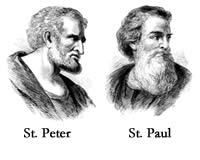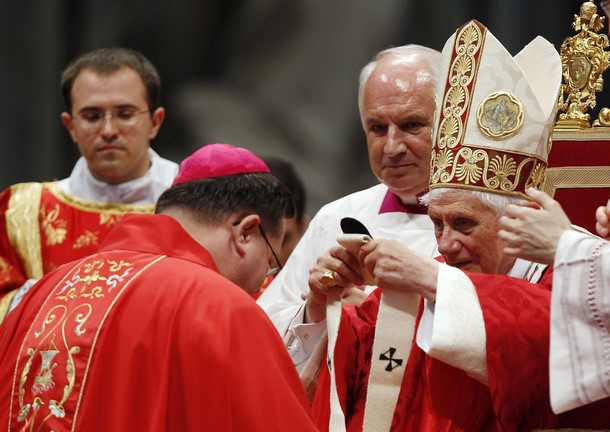 Today will see the return of Pope Benedict XVI to the continent where the Catholic Church only seems to know growth, as he departs Rome for an apostolic journey to Benin. Apart from the usual courtesies and meetings, there are several important points in this three-day visit. As the relevant page on the Vatican website indicates, this visit takes place “on the occasion of the signing and publication of the Post-Synodal Exhortation of the Second Special Assembly for Africa of the Synod of Bishops”. Said Assembly took place during most op October of 2009, and the upcoming Apostolic Exhortation, said to be titled Africae Munus, will collect its conclusions and form something like a game plan for the African Church.
Today will see the return of Pope Benedict XVI to the continent where the Catholic Church only seems to know growth, as he departs Rome for an apostolic journey to Benin. Apart from the usual courtesies and meetings, there are several important points in this three-day visit. As the relevant page on the Vatican website indicates, this visit takes place “on the occasion of the signing and publication of the Post-Synodal Exhortation of the Second Special Assembly for Africa of the Synod of Bishops”. Said Assembly took place during most op October of 2009, and the upcoming Apostolic Exhortation, said to be titled Africae Munus, will collect its conclusions and form something like a game plan for the African Church.

Another personally important part of the visit, at least for the Holy Father himself, will be the opportunity to visit and pray at the tomb of Cardinal Bernardin Gantin, the Beninese prelate who was Cardinal Joseph Ratzinger’s immediate predecessor as Dean of the College of Cardinals from 1993 to 2002. Cardinal Bernardin died in 2008 and his tomb is in the chapel of the St. Gall seminary in Ouidah, about 40 kilometers west of the capital, Cotonou, where the rest of the papal visit will take place.
Following the previous papal visit to Africa (Cameroon and Angelo in March of 2009) many media eyes and ears seem only open to whatever shockingly ‘new’ statement the pope will make now about condoms or some such interesting topic. If there will be such a statement that the media will take and run with, there is a high risk that the more important elements of this journey will be completely snowed under. It happened in the past, it will happen again. Better be aware of it.
Benin, which will host a pope for the third time (Blessed John Paul II visited in 1982 and 1993), has a population of some 8.8 million, of whom 27.1% is Catholic. Other main religions are Islam and Vodun (Voodoo). Many Beninese practice a combination of Muslim, Christian and local beliefs, and it seems likely that Pope Benedict will warn against that. To other African prelates, those of Angola and São Tomé and Principe during their ad limina visit in October, he spoke firmly against the practice of witchcraft in their countries and the threat it is to especially children:
“[T]he hearts of the baptized are still divided between Christianity and traditional African religions. Afflicted by problems in life, they do not hesitate to resort to practices that are incompatible with following Christ (cf. Catechism of the Catholic Church, n. 2117). An abominable effect of this is the marginalization and even the killing of children and the elderly who are falsely condemned of witchcraft.” [To the bishops of the Episcopal Conference of Angola and São Tomé and Principe (C.E.A.S.T.) on their ad Limina visit, October 29, 2011]
The Church in Benin consists of two metropolitan archdioceses and eight dioceses. The two metropolitans are Archbishops Antoine Ganyé of Cotonou and Pascal N’Koué of Parakou. Archbishop Michael Blume is the Apostolic Nuncio to Benin, and also to neighbouring Togo.
Photo credit: 30giorni.it
 Which is also, of course, the Solemnity of Saints Peter and Paul, the rock and the apostle to the gentiles, in many ways the foundations of the Church. And also, it is the day upon which Pope Benedict XVI celebrates 60 years of priesthood.
Which is also, of course, the Solemnity of Saints Peter and Paul, the rock and the apostle to the gentiles, in many ways the foundations of the Church. And also, it is the day upon which Pope Benedict XVI celebrates 60 years of priesthood.